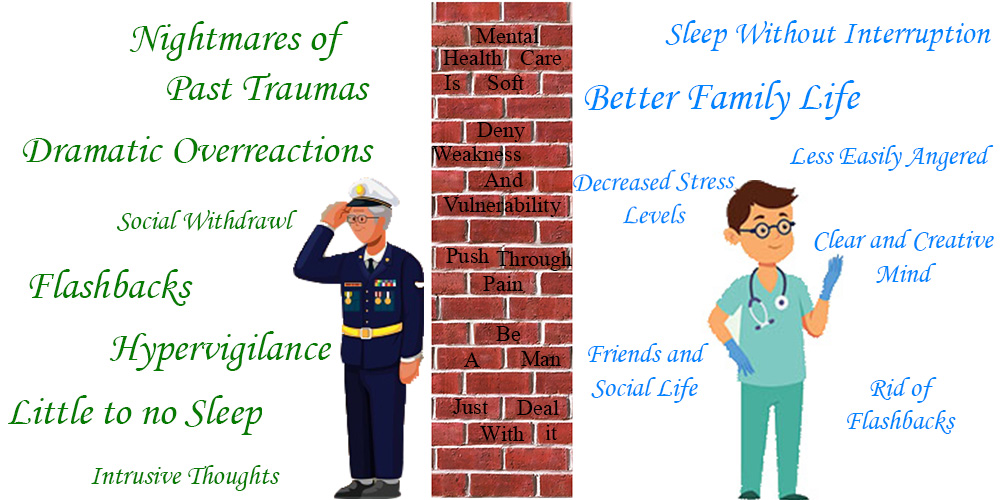
Why do so many veterans choose to handle detrimental forms of mental illness on their own when so many resources are available to them? Clint Van Winkle, for example, is a veteran who fought in the early 2000’s in Iraq for the Marines. After witnessing various traumatic events while on the front lines, he did not seek out help, even after being diagnosed with Post-Traumatic Stress Disorder (PTSD). He did not want to be associated with others too “soft” to solve the problem on their own (Winkle, 2013). His wife worried a new man had come home from the war, and she had lost her husband. Yet, he found help at a Veterans Affairs clinic after finding a therapist he could connect with. Today, he is alive and well. While Clint’s story is common to some veterans, many others do not get help, and their stories did not end up as happy as Clint’s.

Hegemonic Masculinity in Relation to Veterans
Between 14%-16% of deployed military personnel veterans are diagnosed with PTSD, (Gates, Holowka, Vasterling, 2012) as opposed to 7%-8% (Gates, 2012) of non-veterans. Many researchers believe the rate of veterans with PTSD is much higher – around 30% (Reisman M. 2016) – due to the undiagnosed PTSD cases.
Hegemonic masculinity contributes to the reticence to ask for help due to veterans’ fear that receiving help will affect their appearance to others, so they avoid the aid entirely. Hegemonic masculinity is a form of masculinity that justifies the dominance of men (Messerschmidt, 2019). Masculine attributes that fall under hegemonic masculinity very closely align with those valued by the military and have been institutionalized into the United States military. For example, military personnel are taught to “deny weakness and vulnerability” and “emotional and physical control” (Cogan, Haines, and Devore, 2019). All these learned characteristics create barriers which prevent combat veterans who are struggling with mental disorders from seeking and receiving mental health care.
When combat veterans return from war there are many outlets for them to receive mental health care, such as U.S. Department of Veterans Affairs (VA) (a government agency providing funded health care for veterans), but many of these services are not utilized. Many veterans who experience trauma that affects their mental health believe that “using health services was equated with being weak.” (Cogan, 2019) More importantly, they did not want to be seen as “soft” (Cogan, 2019) to the people they fought next to. This mindset clearly illustrates how hegemonic masculinity has been integrated into the US military.
Working to Change
Few efforts had been made to combat veterans’ denial of mental illness, but recently there has been an increase of attention to the matter. The American Public Health Association (APHA) and the VA have begun to put more effort and resources forth to mental illness of veterans. APHA put out various policies to aid in the healing process for veterans. Some of these policies include Policy 7524: Suicide Prevention and Policy 9604: Accountability in the Provision of Health and Welfare Services to Persons with Mental Illness. (Apha.org 2022) Both policies advocate for more equal and available public health care for those in need. This approach accommodates for outside factors, such as, the community you live in, your job, etc. But these policies are focused at the general population rather than veterans themselves.
Additionally, the VA is looking at how to provide long-term support more tailored to veterans themselves. The VA is working to create a system that would work with military personnel through every stage of their service as well as after (from bootcamp until after discharge). The system would also incorporate families, providing support to the service member as well as to their family members. Although the idea of this system is far from becoming a reality, it could be a solution to the barrier created by hegemonic masculinity preventing veterans from receiving mental health care. (Lieberman 2022)
References
A. Lieberman, J., 2022. Solving the Mystery of Military Mental Health: A Call to Action. [online] Psychiatric Times. Available at: <https://www.psychiatrictimes.com/view/solving-mystery-military-mental-health-call-action> [Accessed 17 March 2022].
Apha.org. 2022. Removing Barriers to Mental Health Services for Veterans. [online] Available at: <https://www.apha.org/policies-and-advocacy/public-health-policy-statements/policy-database/2015/01/28/14/51/removing-barriers-to-mental-health-services-for-veterans> [Accessed 9 March 2022].
Cheney, A., Koenig, C., Miller, C., Zamora, K., Wright, P., Stanley, R., Fortney, J., Burgess, J. and Pyne, J., 2018. Veteran-centered barriers to VA mental healthcare services use. BMC Health Services Research, 18(1).
Cogan, A., Haines, C. and Devore, M., 2019. Intersections of US Military Culture, Hegemonic Masculinity, and Health Care Among Injured Male Service Members. Men and Masculinities, 41(10), 623–634.
Connell, R. and Messerschmidt, J., 2005. Hegemonic Masculinity. Gender & Society, 19(6), pp.829-859.
Gates, M., Holowka, D., Vasterling, J., Keane, T., Marx, B. and Rosen, R., 2012. Posttraumatic stress disorder in veterans and military personnel: Epidemiology, screening, and case recognition. Psychological Services, 9(4), pp.361-382.
Messerschmidt, J., 2019. The Salience of “Hegemonic Masculinity”. Men and Masculinities, 22(1), pp.85-91.
Reisman M. 2016. PTSD Treatment for Veterans: What’s Working, What’s New, and What’s Next. P & T : a peer-reviewed journal for formulary management:41(10), 623–634.
Winkle, C., 2013. Soft spots. New York: St. Martin’s Press.